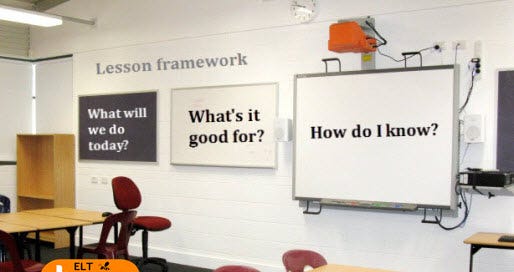Linkedin | Videos | Blog | Printables | ELT News | TpTs | Youtube Channel
“So What Do You Do Now?” is the last question and chapter of Postman and Weingarten’s classic book about teaching and teacher professional development - Teaching As A Subversive Activity.
The authors suggest teachers before doing anything, reflect on and answer these 3 questions about what they'll do in the classroom.
1. What am I going to have my students do today?
2. What is it good for?
3. How do I know?
It is simple approach to setting out what you as a teacher will do in the classroom. It also begs you to ask the question - “What’s worth knowing?” A question central to the curriculum process - the What? Who? How? of our teaching day, week, month, year.
What Am I Going To Have My Students Do Today?
Most teachers handle this question very well. They get to know what activities work for them as a teacher and from the toolkit, build out what will be done in the classroom.
I think central to this for English language teachers is making sure there is a framework that you follow, a step by step routine for what students will be doing. Routines allow us to focus on other aspects of teaching and get everyone on the same page.
The idea is to have a strong set of recipes to follow, activities to do that will easily handle the objectives you will set out for your students.
What is it good for?
This is where your aims, your goals, the language learning objectives need to be aligned with activities. Every activity should have a matching language objective but don’t overdo it with “the students will be able to …” statements. Keep it down to one or two per lesson or even day.
Secondly, don’t think affective objectives aren’t valuable. Sometimes as a teacher, the question “What is it good for?” can be as simple as getting students to feel good about themselves as English language learners, getting them to be more confident by feeling successful. Or it could just be you want the class to work more as a team. Include affective related objectives.
How Do I Know?
Central to the act of teaching is accountability. A teacher needs feedback and must monitor student learning to know if students have mastered a skill or met the learning objective.
Usually teachers will answer the question “How do I know?” by assigning a test or quiz or getting students to rephrase their learning or what they have learned. This can work but isn’t as effective when it comes to something like language that focuses less on memory, on declarative knowledge and more on procedural knowledge.
A teacher must approach this question over a longer time frame and much more formatively. Take an ongoing approach, assess students regularly, outside of their initial learning period and see what has stuck. Also, allow the students to reflect and be metacognitively involved, learning to monitor their own learning and “know when they know”.
This is just one piece from a very fine book - a book I return to often, again and again. You can get a PDF copy in our Lesson Library. There is a lot more there - to help you think outside the usual boxed norms and standards of traditional teacher development courses and training.









Share this post